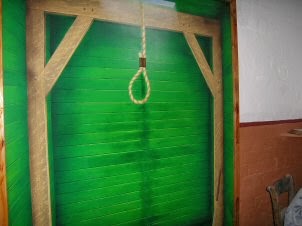Bath Cell
Men ate their grim prison food:
gruel (thin porridge), bread, and scouse ( a boiled-up stew consisting mostly
of potatoes with a little meat ) in their cells. In order to serve the food to
the inmates in their cells the plates fitted into holes in an ingenious trolley
which was pushed along the galleries. Wheels running on the balustrade made the
trolley stable and meant that it could be operated by one person.
The
basement housed punishment cells, workshops, and storage rooms. Of the
punishment cells three were dark, that is no light whatsoever entered, and
access was through a system of double doors which would have closed off most
sound as well. Dark punishment cells were abolished after 1878.
Ruthin's
last execution took place in 1903 when William Hughes, a Wrexham miner, was
found guilty of shooting his wife whom he supposed to be unfaithful. He was
hanged at the prison at 8.00 a.m. on 17th February 1903 and buried on the
prison premises. He was later reburied in the town cemetery after the gaol's
closure.
Condemned Prisoner
The Gallows
Despite
strong local opposition, The Prison Commissioners decided that H.M. Prison
Ruthin should be closed on the grounds of the increasing costs of maintenance.
In 1926 it was sold to the County
Council for £4,000 and was converted into offices and a library. During the
Second World War part of the building was used as a munitions factory. Floors
were inserted in the space between the galleries of the 1886 block and a lift
installed. The County Council returned after the war.
Three Kids Gripped By Evil By Polly Mullaney
Amazon Kindle, Amazon paperback











No comments:
Post a Comment